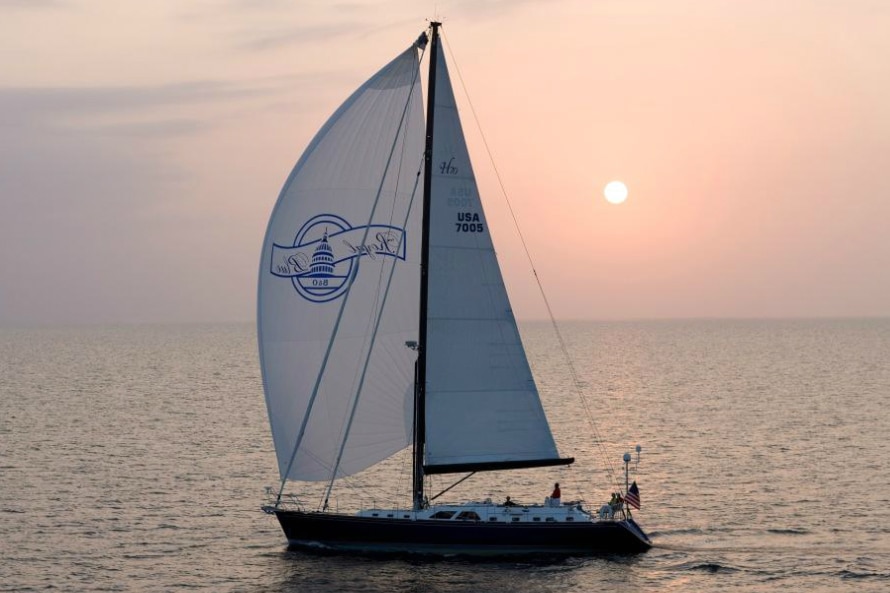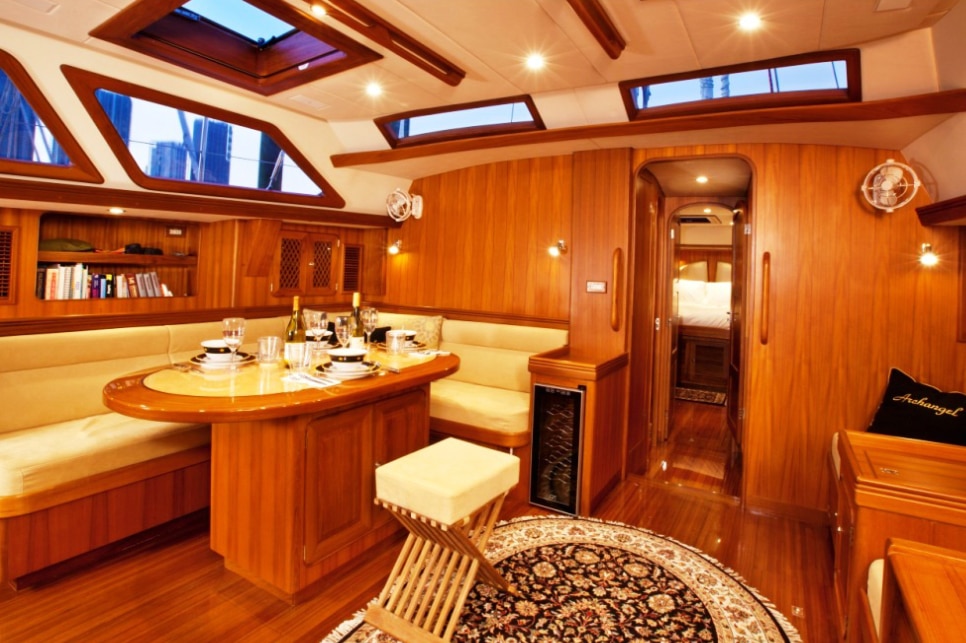
Tim Dickinson dreamed for 20 years about sailing across the Atlantic. But when he reached that time in his life when he was ready to purchase the boat on which to do it, he thought, “Why limit myself to the Atlantic?”
During the course of those 20 years, naturally, Tim’s life had changed in a few ways. Today, he’s a very successful international lawyer, so his purchasing power is significant, and his wife, Anja Lehmann, is now an equal party in any boat-buying decision. The young man who might once have taken a berth on almost any Europe-bound cruiser/racer is now a middle-aged man with means, a taste for creature comforts, and a wife with similar aspirations. A vision of a yacht with style and generous accommodations arose to occlude that of the transport of his youth.
After much research into builders of boats of the caliber they sought, Tim and Anja found that vision embodied in the apex of the Hylas line, the Hylas 70, designed by German Frers and built in Taiwan by Queen Long. The couple’s Angkor Wat is the product of two years of lively discourse-discussion, cooperation, and a degree of dissent-among the builder, Kyle Jachney of Hylas USA, Tim, Anja, and Jeff Van Alstine, the professional captain who helped guide them through the specification and installation of the equipment, some of it quite specialized, that a vessel of this size and built for this purpose demands.
The ultimate objective for Angkor Wat is to take Tim and Anja around the world, but the first year or so of operation has been devoted to training her owners in her care, upkeep, and sailing. “Two people can sail this boat reasonably comfortably,” Tim announced as we edged out of the boat’s berth at Port Annapolis Marina, in Back Creek, in Annapolis. “Not Anja and I, yet, but they can.” He gestured toward Holly and Alan Sawyer, sister and brother-in-law of Van Alstine, who were aboard for the season to provide professional and moral support while Angkor Wat’s owners familiarized themselves with the vessel’s scale and operating systems.
“At this point,” Tim said, as the light breeze hinted at building a little, ruffling the Severn River, “I feel confident taking the boat for a daysail on a day like this, but I wouldn’t contemplate just the two of us taking her on an offshore passage.”
Tim has sailed most of his life. He began in the racing classes around his home in Michigan, but for 15 years he favored “boards over boats” and sailed windsurfers. After he and Anja were married (they met in Cambodia, where they were both doing legal work pro bono), they looked for activities they could share, and he proposed sailing. Because this would be an entirely new experience for her, to test the idea, he bought a Beneteau 281 and took her sailing on it on the Great Lakes. The outcome was positive, so they bought a Beneteau 393 to provide greater range and comfort and as a stepping-stone toward adventures farther afield.
Anja had spent a good part of her life in structured learning environments and preferred to follow the same route for learning to sail: “I’m not big into learning by doing,” she says. She likes to get “meat on the bones,” so she took lessons from a local instructor as well as courses at the Offshore Sailing School. She expressed an inclination to study celestial navigation, as much for the intellectual challenge of determining her position at sea from nature’s heavenly bodies as for its practicality in the event that manmade ones fail. Meanwhile, as well as sailing their own Beneteau, the couple gained practice and experience by chartering boats every year for several years in different areas of the Caribbean. They also attended seminars, including those presented by Steve Black, the organizer of the Caribbean 1500 rallies, and went to a North Sails sail-trim class.
As they broadened their horizons and their general cruising knowledge, Tim and Anja narrowed down the field of boats and builders they felt could satisfy their desire to sail around the world in the biggest boat they thought they could handle by themselves. After two years, during which the boat grew from the mid-50-foot range, they hired Robert H. Perry as an advisor, eliminated aluminum as a material, and zeroed in on the Hylas 66.

Even then, although the Hylas workmanship, from fundamental construction to system installations to joiner work, met their demands, the Hylas 66 wasn’t quite what Tim and Anja wanted. When Kyle Jachney proposed the extended version, the Hylas 70, with its redesigned deck, they bit. But Tim didn’t want the first hull; he’d heard too many tales of Hull Number One-itis. He was prepared to wait while someone else worked through the teething problems inevitable in a new boat of such size and complexity. Angkor Wat is the fifth hull in the Hylas 66/70 line.
Tim signed the papers for the boat in 2006, and during the two-year construction period that ensued, Tim, Anja, and Van Alstine visited Taiwan frequently to inspect the work carried out and plan for subsequent phases. It was in these meetings, often with representatives from Hylas present, that many of the final decisions on equipment were agreed upon.
“I didn’t always get my way,” says Tim. “We agonized over the rig. I wanted in-mast furling, but I couldn’t get anyone to agree with that.” As a result, the mainsail furls into a Leisure Furl boom, its mandrel driven by a hydraulic motor.
In early Leisure Furl systems, the motor was mounted on the fore side of the mast, its shaft connected to the mandrel by a universal joint. Current models place the motor in the aft end of the boom, which is better from the standpoint of operating the system but puts the motor at risk of a dunking in a heavy seaway. A hydraulic motor is less vulnerable than an electric motor, so its choice played into the decision to go hydraulic with all of the deck gear: the winches, windlasses, and furlers.
That decision itself stems from a key objective. As Anja put it, “Our goal was to keep things simple, if that’s not an oxymoron on a boat of this size.” It is, of course, but the desire allowed them to question the need for every single item that found its way onto the spec sheet. In the end, they succeeded, to the degree that that’s feasible while making it possible for two people to operate the boat. Hence the decision, taken hesitantly at first, to go with hydraulics: It’s easier to transmit power over long distances by hydraulics than with low-voltage electricity.
Even more important than simplicity, in Tim’s view, is safety. For that reason, the winches can’t be operated remotely; the operator has to be at the winch and thus able to see that it’s clear of entanglements, such as the clothing of an unsuspecting passenger. Redundancy, too, plays its role in the “simple and safe” mantra. Critical systems have backups (two central hydraulic pumps, two pressure-water pumps), and manual ones, too, where feasible (all five fuel and four water tanks can be dipped for a visual check). And while the electrical panel looks as busy and lit up as a Boeing’s cockpit, it provides control of every circuit at the boat’s nerve center, which is a combination nav station and office. Tim gives much credit for the organization of the systems and the control panel to Van Alstine, who also happens to be a pilot.
If Tim was focused on the mechanical and electrical components (“I didn’t want anything last generation on this boat,” he said), Anja brought a similarly modern view to the interior appointments. To her European eye-she’s from Germany-some aspects of the Hylas style were a little too simple or traditional. She sought a more contemporary look and requested, for example, that the flat, teak-veneered surfaces of the bulkheads and partitions be made a little more visually interesting. The Hylas craftsmen obliged, carving horizontal grooves to create a paneled effect, which picks up on the beading around the locker doors. The treatment, complemented by textile coverings on some surfaces, brings more intimacy to the cabins, its effect further enhanced by the pale bamboo cabin sole, which underlies the entire accommodations.
The reason Tim had to edge Angkor Wat gingerly from her berth at Port Annapolis is that she draws just over eight feet-with the centerboard raised-and it was low tide. In the year that they’ve been sailing her, which has included spells in Florida, New England, and on Chesapeake Bay, they’d not often bothered with the board, which drops to a draft of 11 feet 10 inches. Nor did they that day, when the light breeze let the boat show off her waterline advantage over every other sailboat that came within view. In those conditions, the genoa was reluctant to tack through the slot between the headstay and inner forestay. The easy solution is to simply furl some of it and unfurl it on the new tack, though manhandling the sail worked, too. If the challenge is to tack up a narrow channel, the staysail will serve adequately.
Twin steering stations aft of the seating cockpit and a step higher offer the helmsman a choice of vantage points from which to check luff telltales and scan the horizon, and they allow a clear walkway to an aft deck expansive enough to hold a playpen.
Which, given that the couple was expecting the birth of their child within months, might well be next on the equipment list.
Their original plan had been to set off on a circumnavigation in 2009, with no hard-and-fast schedule. In light of the anticipated arrival, Tim was making new plans. First, Angkor Wat would be stored ashore in Annapolis for the winter. In the spring, Tim’s thought was to sail her up the St. Lawrence River and on to Michigan. That in itself is a cruise of a lifetime for many, and it would bring the boat to their home near Ann Arbor. From there, she could introduce their new crewmember to some of their familiar Great Lakes destinations, such as Lake Huron’s North Channel, where the journey to Angkor Wat began.
Jeremy McGeary is a CW contributing editor.








